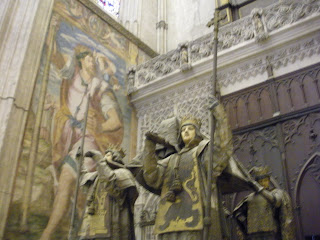
The largest Gothic church in world and the third largest Christian church after St. Peter’s Basilica in  nt and visible architectural monument. Along with the towers of the Plaza de España to south, it dominates the medieval four story skyline of the city center. Built atop the foundations of a former Islamic mosque dating to the twelfth century, construction on the bulk of the present Christian structure continued throughout the fifteenth century. Although much of the original mosque was demolished during this process, the minaret and courtyard, now the Cathedral’s bell tower and the Patio de los Naranjos, respectively, remained virtually intact. As a final testament to the ages, Roman columns fashioned by the city’s earliest inhabitants were placed in a continuous ring about the building.
nt and visible architectural monument. Along with the towers of the Plaza de España to south, it dominates the medieval four story skyline of the city center. Built atop the foundations of a former Islamic mosque dating to the twelfth century, construction on the bulk of the present Christian structure continued throughout the fifteenth century. Although much of the original mosque was demolished during this process, the minaret and courtyard, now the Cathedral’s bell tower and the Patio de los Naranjos, respectively, remained virtually intact. As a final testament to the ages, Roman columns fashioned by the city’s earliest inhabitants were placed in a continuous ring about the building.
Referred to simply
Within the Cathedral are housed some of the finest works by the 
The Cathedral also serves as the final resting place of Christopher Columbus (picture at bottom), at least officially. Although the famous explorer was first buried on the island of Hispaniola, the body was  disinterred and taken to Havana in the late eighteenth century. After Spain lost Cuba to the United States in 1898, the remains were taken to Sevilla. The discovery of a casket bearing the name Cristobal Colón in Santo Domingo during the nineteenth century led some to believe that the actual body never made it off the island of Hispaniola. Although DNA testing appears to validate the remains in Sevilla, authorities in the Dominican Republic have never conceded to similar testing.
disinterred and taken to Havana in the late eighteenth century. After Spain lost Cuba to the United States in 1898, the remains were taken to Sevilla. The discovery of a casket bearing the name Cristobal Colón in Santo Domingo during the nineteenth century led some to believe that the actual body never made it off the island of Hispaniola. Although DNA testing appears to validate the remains in Sevilla, authorities in the Dominican Republic have never conceded to similar testing.
Stay tuned for a few lighter, less historical, posts in the next few installments.

No comments:
Post a Comment